Trying to decide between the .30-30 Winchester and .45-70 Government cartridges? Here’s what you need to know about them.
I think most hunters would agree that the .30-30 and .45-70 are both fantastic lever-action cartridges for hunting all sorts of big game. Both offer certain advantages to hunters, but there are some significant differences between the 30-30 vs 45-70 cartridges you should be aware of.
Both are extremely popular cartridges among those who love hunting with a lever gun and both have proven track records afield over the past century. However, while there is an overlap in their capabilities, the two cartridges are really best suited for different hunting situations.
In this article, I’m going to do a detailed comparison of the 30-30 vs 45-70 cartridges in order to show the differences between them and cover the pros and cons of each one so you can decide which cartridge will work best for you.
Table of Contents
Before we get started, I have a couple of administrative notes:
Some of the links below are affiliate links. This means I will earn a small commission (at no extra cost to you) if you make a purchase. This helps support the blog and allows me to continue to create free content that’s useful to hunters like yourself. Thanks for your support.
History Of The .45-70 Government & .30-30 Winchester
First, I recorded an entire podcast episode on this exact subject. If you’d rather listen or watch than read, watch the YouTube video below.
The American Civil War and the years immediately following the conflict saw a surge in development of new breech-loading rifles and cartridges using metallic cases in the United States. Not surprisingly, the United States Army began the search for a new cartridge and breech-loading rifle to replace the muzzleloading rifles and paper cartridges most American Soldiers still primarily used at the time.
After temporarily adopting the .50-70 Government cartridge and the single shot Springfield Model 1866 breech-loading rifle as a short-lived improvement over the more primitive muzzleloading rifles used during the Civil War, the Army adopted an even more improved rifle/cartridge combination as a replacement in 1873.
The single-shot 1873 Springfield rifle (better known as the Trapdoor Springfield) served as the primary service rifle used by the United States Army until the .30-40 Krag came along a couple decades later. The rifle debuted with a new .45 caliber cartridge using a powder charge of 70 grains of black powder in a copper case. The Army used a couple of different loads firing either 405 grain or 500 grain bullets for the cartridge.
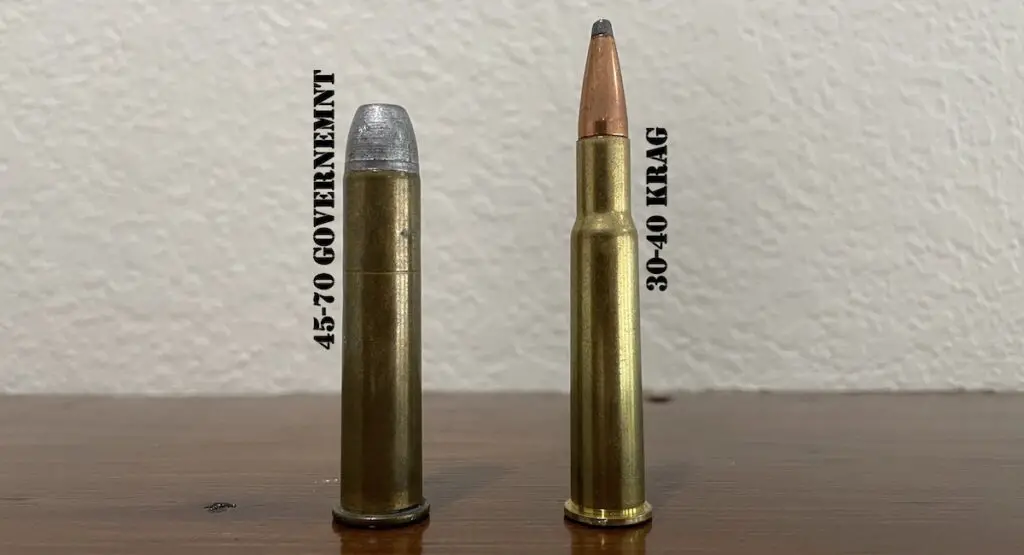
These performance specifications are where the name of the cartridge comes from.
The standard naming convention in common use at the time that consisted of the caliber of the cartridge followed by the standard load of powder in grains. Since the new cartridge was designed at the United States government operated Springfield Armory and used either a 405 grain or a 500 grain, .45 caliber bullet (.458″ diameter) propelled by 70 grains of powder, the cartridge received the designation “.45-70-405” or “.45-70-500” depending on the exact load.
Commercial publications and catalogs also soon began referring to the cartridge as the “.45-70 Government” (.45-70 Govt or .45-70 Gov for short).
This original black powder load pushed a cast lead bullet at a velocity of about 1,350 feet per second. Producing more than 1,600 foot pounds of muzzle energy, this cartridge was one of the most powerful loads available at the time and was effectively used by the Army through the Indian Wars in the late 1800s.
The U.S. Army continued to use various models of this rifle and cartridge in limited numbers through the Spanish-American War and Philippine Insurrection in the late 1800s and early 1900s when the Springfield 1892 “Krag–Jørgensen” rifle started to replace the Trapdoor Springfield.
In addition to the many variations of the Trapdoor Springfield the Army used, several early Gatling Gun models fired the .45-70 Government cartridge. The US Navy and Marine Corps also used the cartridge in a few different rifles as well.
Due to excellent the reputation the cartridge earned while in use with the Army, the .45-70 Govt also quickly became popular among sportsmen in the United States. In response to significant demand for good rifles chambered in the cartridge, it didn’t take long for the major manufacturers to begin building .45-70 Govt rifles specifically marketed and designed for civilian hunters.
Soon, hunters had access to a number of high quality lever action and single shot rifles and repeaters such as the Remington-Keene, the Remington Rolling Block, the Sharps 1874 “Buffalo Rifle,” the Winchester-Hotchkiss, Winchester Model 1885 “High Wall,” and the Winchester Model 1886. Even when using the relatively simple solid lead bullets available at the time, the .45-70 was an extremely effective on game ranging from whitetail deer and black bear all the way up to the larger, tougher, and sometimes more dangerous species like moose, grizzly bear, and bison.
If you’re interested in learning more about the .45-70 Government cartridge in detail, read the article below.
45-70 Govt: The Ultimate Guide To What You Need To Know
The replacement of the .45-70 Govt in military service by the 30-40 Krag and eventually the 30-06 Springfield roughly coincided with the beginning of widespread adoption of smokeless powder cartridges.
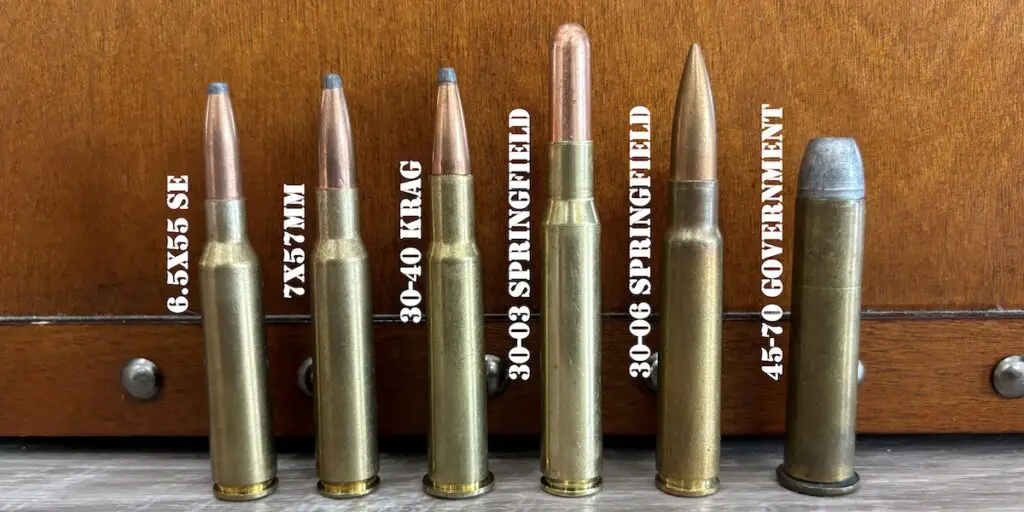
Well, the .30-30 Winchester made history as the first sporting cartridge loaded exclusively with smokeless powder.
First introduced by Winchester Repeating Arms in 1895 for their Model 1894 rifle, Winchester originally named the cartridge we now know as the .30-30 the “.30 Winchester Smokeless.” The new cartridge carried a “.30 WCF” (short for .30 Winchester Center Fire) headstamp.
However, the management at rival gun manufacturer Marlin knew a good thing when they saw it and adopted the cartridge for use in their Model 1893 rifle several months later. Not wanting to give Winchester (their competitor) free advertising, Marlin worked with the Union Metallic Cartridge Company (UMC) to produce identical ammunition with the designation .30-30 Smokeless, or just .30-30 (thirty thirty) for short.
Just like the origin of the .45-70 name, UMC derived those names by using the black powder naming convention in common use at the time that consisted of the caliber of the cartridge followed by the standard load of powder in grains. Since the new Winchester cartridge used a .30 caliber bullet (.308″ diameter) propelled by 30 grains of smokeless powder, the cartridge received the designation “.30-30.”
Despite the best efforts of the management at Marlin, the name .30-30 Winchester eventually stuck and the cartridge now carries a “.30-30 Win” headstamp.
Made by necking down a 38-55 Winchester case to .30 caliber and utilizing smokeless powder as a propellant, the original .30-30 Winchester load used a 160 grain bullet propelled at 1,970 feet per second (1,379 ft-lbs of energy). This was a significant step up in performance compared to the two black powder cartridges available in the Winchester Model 94 at the time: the .32-40 Winchester (165gr bullet at approximately 1,450fps for 770ft-lbs of energy) and the .38-55 Winchester (255gr bullet at approximately 1,320fps for 987ft-lbs of energy).
The .30-30 Winchester came along before bolt-action rifles really started becoming common and most hunters in the United States still used lever action rifles. So, by introducing a new cartridge that was both dramatically more powerful than the competition and available in a dependable, lightweight, easy to handle, and reasonably priced rifle in the Model 1894, Winchester created the perfect conditions for a major commercial success with the .30-30 Winchester.
Not surprisingly, hunters all over North America, quickly started snapping up the new rifles and cartridges. Over the years, the .30-30 Winchester has gained a reputation as a wonderful cartridge for hunting deer, black bear, and feral hogs at short to moderate range.
Indeed, it’s possible that American hunters have taken more deer with Model 1894 rifles chambered in .30-30 Winchester than any other rifle/cartridge combination.
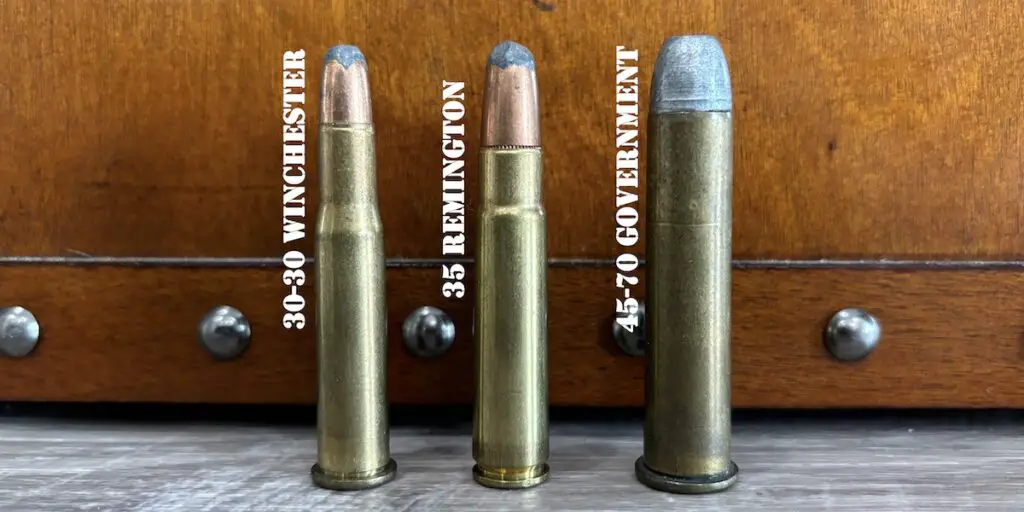
The 30-30 Winchester remains incredibly popular to this day and, along with the 35 Remington and 45-70 Government, is easily one of the most common chamberings in lever-action rifles.
Additionally, the fact that competitors like Remington have specifically marketed their cartridges as better alternatives to the .30-30 (like Remington did with the .35 Remington), and that the .30-30 case has spawned so many wildcat and factory derivative cartridges (like the .219 Zipper, 25-35 Winchester, 7-30 Waters, and 360 Buckhammer), are both testaments to the popularity and longevity of the cartridge.
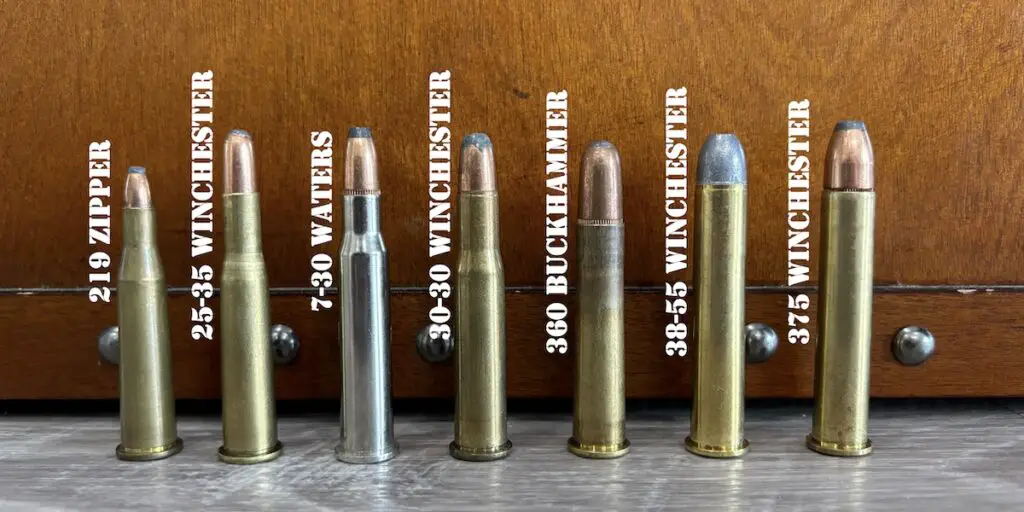
If you’re interested in learning more about the .30-30 Winchester cartridge in detail, read the article below.
30-30 Winchester: Still Relevant A Century Later
45-70 vs 30-30: Cartridge Sizes
You can see differences between the .30-30 Winchester and the .45-70 Government in the photos below.
First, the .45-70 Govt is physically much larger than the .30-30.
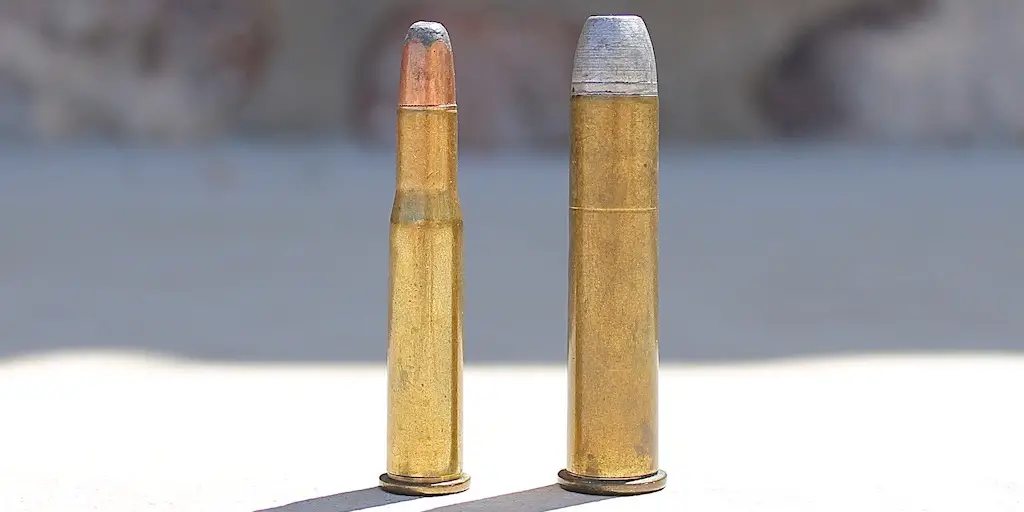
While the two cartridges have the same maximum authorized overall length of 2.55″, the .45-70 Govt uses a larger diameter case than the .30-30. Specifically, the .45-70 Govt has a larger .608″ rim diameter while the .30-30 has a .506″ rim diameter.
Additionally, while they’re both rimmed cartridges, the .45-70 uses a straight-wall case while the .30-30 uses a bottle necked case.
The end result is that the .45-70 Government has a much larger case capacity than the .30-30 Winchester.
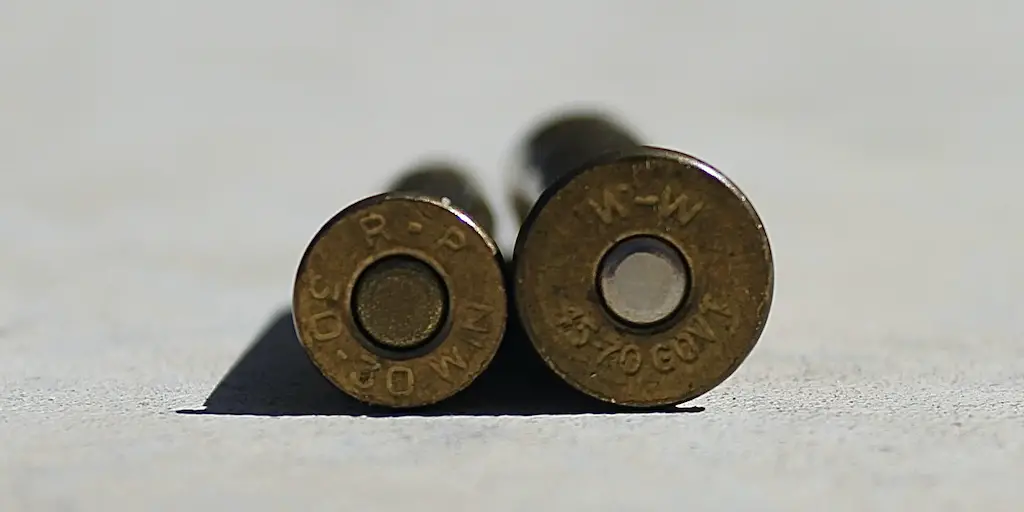
Bullet size is another one of the other obvious differences between the 30-30 vs 45-70. Each cartridge uses different diameter bullets: .308″ for the .30-30 cartridge and .458″ for the 45-70.
The vast majority of .30-30 Winchester factory loads shoot bullets in the 140-190 grain range. Of these, 140 grain, 150 grain, 160 grain, and 170 grain bullet weights are by far the most common.
On the other hand, though it’s possible to find .45-70 ammo shooting bullets weighing as little as 250 grains and as heavy as 500 grains, most .45-70 factory loads use 325 grain, 350 grain, or 405 grain bullets.
The .30-30 Winchester also has a higher maximum SAAMI authorized pressure than the .45-70 Government (42,000psi vs 28,000psi).
These pressure figures can be somewhat misleading though.
This is because the .30-30 Winchester was designed from the start to use smokeless powder, while the .45-70 Govt was originally designed for black powder before being adopted to use smokeless powder.
Since there are so many older Trapdoor Springfield rifles still out there, ammunition manufacturers download many of their factory loads for safe use in those rifles. That said, modern rifles like the Marlin 1895 use much stronger actions and are safe to use with higher pressure ammunition.
We’ll cover this in more detail later in the article, just realize that the SAAMI standards for the .45-70 are artificially low for that reason.
Note: while the powder capacity figures listed below do give a good indication of the differences between the two cartridges, exact case capacities vary slightly according to the brand of brass used.
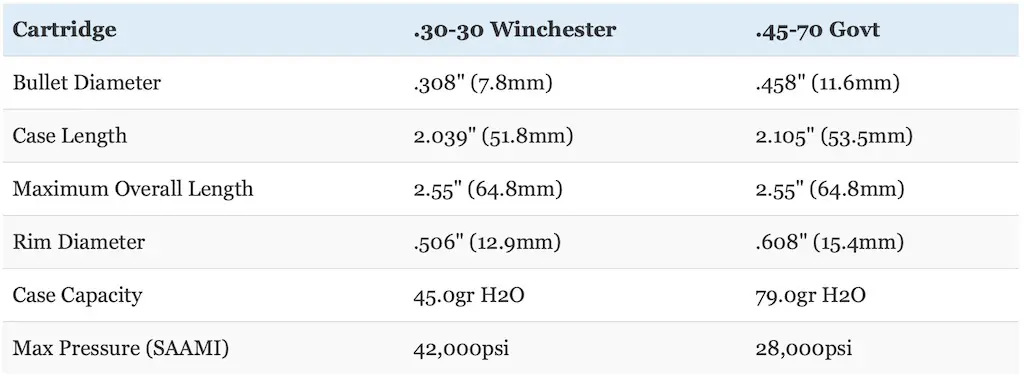
45-70 vs 30-30 Ballistics
Not surprisingly, the differences in the external dimensions of the .30-30 Winchester and the .45-70 Government translate into some pretty significant differences in their ballistic performance. This is illustrated in the table below comparing Hornady LEVERevolution, Remington Core Lokt, and Buffalo Bore factory ammunition.
The table below compares 160gr and 325gr Hornady FTX (.330 and .230 BC), 170gr and 405gr Remington Core-Lokt (.254 and .281 BC), and 190gr and 405gr Buffalo Bore Jacketed Flat Nose (.339 and .216 BC) loads for each cartridge.
Note that the 405gr Remington Core-Lokt (.281 BC) .45-70 Govt ammunition essentially duplicates the original .45-70 loading.
All six loads used a 100 yard zero.
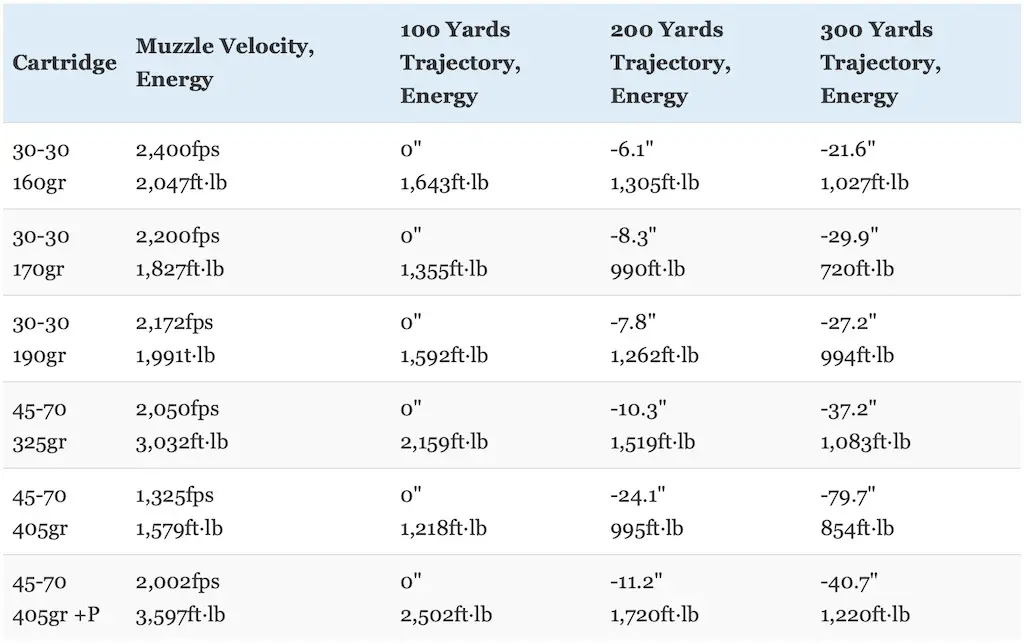
In terms of external ballistics, the .30-30 has a 200-400 fps advantage in muzzle velocity over the .45-70, but the .45-70 uses significantly heavier bullets and has much more muzzle energy than the .30-30. That advantage in energy does narrow as the range increases, but neither cartridge is really ideally suited for longer ranged shooting. At ranges inside 150 yards (where they’re both strongest), the .45-70 has a clear advantage of the .30-30 in the energy department.
Specifically, with the exception of the low powered .45-70 load, the .45-70 Government has about 48-97% more muzzle energy than the .30-30 with these three particular loads. So, the .45-70 Govt is much more powerful than the .30-30, which isn’t too surprising considering their differences in external dimensions.
With all that said though, it’s important to note that the .30-30 Winchester has a flatter trajectory with less bullet drop. The .30-30 isn’t normally considered a good long range cartridge, but it certainly has a definite edge over the .45-70 in that regard.
At 300 yards, the various .45-70 loads have about 7-19″ (23-88%) more bullet drop than the .30-30 loads. While I wouldn’t necessarily advise taking shots on game with the .30-30 out at 300 yards, the situation is different at 200-250 yards and the .30-30 also has the edge with bullet drop there.
That of course does not include the .45-70 Core Lokt ammunition that mimics the ballistics of the original .45-70 load. That particular load has less than half the muzzle energy of the more modern .45-70 loads and about 15% less muzzle energy than the least powerful .30-30 load. It also has by far the most arching trajectory of these six loads with more bullet drop at 200 yards than the Hornady .30-30 load at 300 yards.
This is a good example of how modern smokeless powders really pushed the .45-70 into a whole new level of performance.
We’ll talk more about those numbers and what they mean in a minute.
Now let’s talk about recoil.
The table below compares the recoil produced by handloads that more or less mimic the performance of the Hornady LEVERevolution loads from above when fired from identical 8 pound rifles.
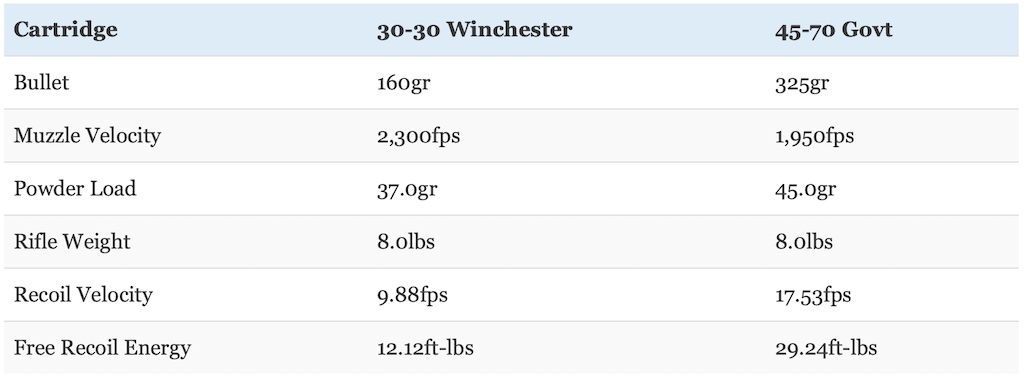
Felt recoil will vary from shooter to shooter and rifle to rifle, but free recoil energy is still a useful way to compare cartridges.
As you can see, the .45-70 Government has more than twice as much recoil as the .30-30!
That should not be surprising at all. After all, the .45-70 Government is a heavy hitting big bore rifle cartridge, which the .30-30 Winchester is a mild mannered deer cartridge known for moderate recoil.
Basically, the .45-70 Government should be expected to hit a little harder on both ends, which is exactly the case.
While the .45-70 does indeed have quite a bit more recoil than the .30-30, we’re not talking about ridiculous amounts of recoil here either. For reference, this particular .45-70 load recoils about as much as many 7mm Rem Mag or .300 Win Mag loads and has less than half the free recoil energy of the .458 Winchester Magnum.
Additionally, this recoil can be mitigated to a certain extent with the use of a muzzle brake or a good recoil pad. So the extra recoil of the .45-70 isn’t necessarily a deal breaker for many people and lots of hunters handle it without issues.
Recoil is certainly worth considering though. Don’t underestimate the impact that recoil has on the ability of a person to shoot accurately either. Some people do handle recoil better than others, but all other things being equal, they will absolutely shoot more accurately with a milder recoiling cartridge.
Additionally, we can’t have a discussion these two cartridges without covering the importance of bullet diameter. As I mentioned earlier, the .45-70 uses larger diameter bullets than the .30-30.
Specifically, the larger diameter .458″ bullets used by the .45-70 have more than twice as much frontal surface area (also known as cross sectional area) as the .308″ bullets used by the .30-30 (.1647 vs .0745 square inches). All other things being equal, a bigger bullet will make a bigger hole, cause more tissue damage, and result in more blood loss.
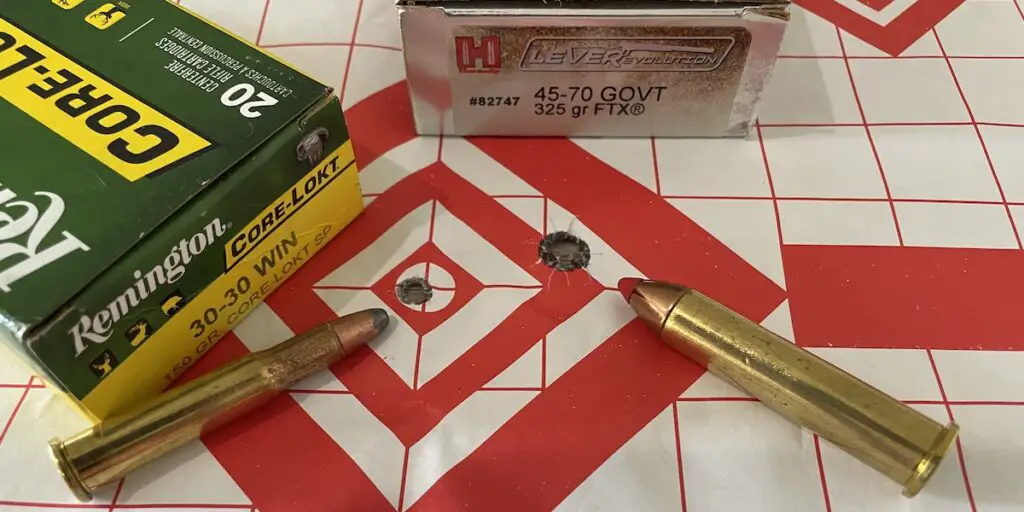
This is a big factor in favor of the .45-70.
What about 45-70 vs 30-30 accuracy?
It’s tough to pick a winner here. Both cartridges are capable of good accuracy, but neither one is really known for precision shooting.
The .45-70 is still used by many black powder silhouette shooters and both cartridges are used by cowboy action shooters, but that’s about the extent of their usage for competitive shooting.
Additionally, it’s unusual to encounter rifles chambered in either cartridge that are exceptionally accurate. As we’ll cover here shortly, both cartridges are most commonly available in lever-action rifles.
For a number of reasons, lever-action rifles are generally not quite as accurate as bolt action rifles. However, this isn’t really that big of an issue for most hunters and good lever-action rifles are usually still accurate enough. You probably won’t be shooting sub-MOA with a rifle chambered in either cartridge, but a rifle that shoots 2 or 2.5 MOA is still plenty accurate for just about anything you’d be using a lever action rifle for.
Like I said, that’s not to say that these cartridges aren’t capable of great accuracy at times or are strictly limited to short range shots. Indeed, the .45-70 was a “long range” cartridge back when it first came on the scene.
Buffalo hunters back in the late 1800s, used “tang” or “ladder” iron sights with Vernier scales that allowed for very precise elevation adjustments. As long as he estimated the range correctly, a skilled marksman using a high quality rifle and sight could accurately hit targets out past 1,000 yards using the .45-70. That said though, hitting a target at 1,000 yards is a far cry from taking a shot on an animal at that range.
Due to these constraints, while the .45-70 Govt is popular among black powder silhouette shooters, few modern hunters use the cartridge at ranges past 200 yards.
The same is true to a certain extent with the .30-30 Winchester. That cartridge does have an advantage with a flatter trajectory and less recoil, both of which facilitate better shot placement.
So, it’s possible that the .30-30 Winchester may have a tiny edge in accuracy potential at typical hunting ranges, but it’s not a big edge.
Where do we stand with each cartridge?
30-30 vs 45-70
The .30-30 shoots lighter and smaller diameter bullets than the 45-70 Government. With modern factory ammo, the .30-30 normally has a higher velocity, less recoil, and less bullet drop at most ranges. However, the .45-70 has substantially more muzzle energy and more retained energy at typical hunting ranges.
Since the .45-70 Government has so much more kinetic energy and shoots significantly larger diameter and heavier bullets, it’s clearly the more powerful of the two cartridges. It’s also hands down the best option for hunting really big and/or dangerous North American game animals. This power does come at the expense of a lot more recoil though.
On the other hand, with a flatter trajectory, less recoil, and plenty of power for hunting deer sized game at short to moderate range, the .30-30 is a wonderful choice for deer sized game. There’s no question the .45-70 is the better choice for bigger game, but the .30-30 gets the job done on critters like deer, black bear, and feral hogs without nearly as much recoil.
30-30 vs 45-70 Ammo
Both the .30-30 Winchester and the .45-70 Government are extremely popular centerfire rifle cartridges. In fact, they’re easily the two most popular cartridges used in lever-action rifles in North America. That said, the .30-30 Winchester is a little more common in general, though the .45-70 Government is by no means rare.
For example, Sportsman’s Warehouse currently lists 45 30-30 Winchester loads and 38 45-70 loads on their site as I type this.
The big ammunition manufacturers like Barnes, Buffalo Bore, Federal Premium, Hornady, Nosler, Remington, and Winchester all produce a good selection of .30-30 Winchester and .45-70 Govt ammunition in popular hunting ammo lines. For instance, the Barnes VOR-TX, Federal Power Shok, Remington Core Lokt, and Winchester Power Point lines all include both cartridges.
So, they’re both in common use and ammo is usually easy to find for both. Availability also likely varies regionally though. For instance, more people tend to use the .45-70 Government up in Alaska where its hard hitting characteristics are useful on creatures like moose and brown bear.
In general, .30-30 ammo is typically less expensive than .45-70 ammo.
For example, Sportsman’s Warehouse currently sells 30-30 Winchester ammunition for between $0.75 and $4.50 per round (not including sales tax or shipping).
On the other hand, they list 45-70 Government ammo for $1.10 to $5.50 per round.
Since the .30-30 Winchester and .45-70 Govt are both very popular in lever-action rifles with tubular magazines, most loads feature a round nosed or flat-tipped bullet. This is because bullets are stacked one in front of the other and recoil could potentially cause a bullet with a pointed tip to detonate the primer of the cartridge in front of it.
Unfortunately, those round or flat nose bullets have a low ballistic coefficient and poor downrange performance.
In particular, designers at Hornady attempted to solve that problem with their “LEVERevolution”, line of ammunition for cartridges like the .30-30 Winchester, .35 Remington, and .45-70 Govt that are popular in lever guns. This ammo is loaded with bullets that have a pointed, flexible, polymer tip.
While it doesn’t bring them up anywhere close to the level of stuff like the new hot rod 7mm PRC, LEVERevolution ammunition does use more aerodynamic bullets and generally has a higher velocity than typical ammunition for those cartridges. As a result, this ammunition does have a slightly flatter trajectory, a slightly increased effective range, and retains more energy at typical hunting ranges.
During normal times, it’s usually very easy to find ammo for both cartridges and almost any gun or sporting goods store will have a wide variety of .30-30 and .45-70 ammo in stock.
BUY SOME GREAT 30-30 AMMO HERE
BUY SOME EXCELLENT 45-70 AMMO HERE
If you’d like to learn more about some of the various hunting ammunition choices for the .30-30 Winchester and .45-70 Government cartridges, read these articles:
Best 30-30 Ammo For Hunting Deer And Other Big Game
Best 45-70 Ammo For Hunting Deer, Bear, Moose And Other Big Game
Handloaders will appreciate the fact that reloading components for both cartridges are also readily available and there’s an especially wide variety of bullet choices for each cartridge. So, you should not have any trouble working up a good custom load for either one if you like to handload.
The .30-30 Winchester uses the same .308″ bullet size as the .300 Blackout, .308 Winchester, .30-06 Springfield, .300 Win Mag, 300 WSM, .300 Ultra Mag, and .300 PRC.
The .45-70 Government uses the same .458″ bullet size as the .458 SOCOM, .450 Marlin, .458 Win Mag, and .458 Lott.
Bullets like the Barnes TSX, the Hornady FTX and Monoflex, and the Nosler Partition (just to name a few) are options for if you want to reload the .45-70 and .30-30. Lots of people who roll their own also use plain old cast bullets in each cartridge as well.

45-70 vs 30-30 Rifles
There is also a pretty good selection of good hunting rifles chambered in both .30-30 and .45-70, though once again, there are more options for rifles in .30-30. Since they’re both rimmed cartridges, the .30-30 Winchester and .45-70 Government are most commonly, though not exclusively, chambered in single shot and lever action firearms (with the notable exception of the Browning BLR, which is not available in either one).
If I had to guess, I’d say a Marlin 1895 (top in the photo below) is the most iconic 45-70 rifle while a Winchester Model 1895 (bottom in the photo below) is the most iconic 30-30 rifle.

In addition to the Winchester Model 1894 and the Marlin 1893 that were first available in .30-30 Winchester, the Savage Model 99 was a very popular rifle in that chambering for many years.
The Marlin 336 is currently one of the most popular rifles currently manufactured in .30-30. Additionally, Henry has produced several lever action models in .30-30 (like the Henry All-Weather) as has Mossberg with the Mossberg 464, 472, and 479.
Though it was never really a popular cartridge for bolt action rifles, Winchester produced the Model 54 in .30-30 for a time. They also made a very small number of Model 70s in the cartridge as well.
Remington and Savage (and a few others) also produced bolt-action rifles in 30-30, like the Remington 788 and the Savage Model 340 respectively.
Thompson Center has also produced their break action single shot Contender rifle and handgun in the cartridge for many years. Ruger has also produced the Ruger No. 1 single shot in .30-30 as well.
In addition to the rifles and carbines originally chambered in .45-70 from the late 1800s that are still floating around out there, there are several different firearms in current production chambered in that cartridge.
Specifically, the Marlin 1895 lever action (which is the bigger brother to the Marlin 336) is likely the single most popular rifle manufactured in .45-70. Those Marlin rifles are available in several configurations with different barrel and magazine lengths and styles as well as various finishes.
For instance, as I type this in 2024, Marlin currently offers a stainless SBL model with a 19.1″ barrel, a “Dark” model with a 16.17″ barrel, a Guide Gun model with a 19.1″ barrel, and a Trapper model with a 16.17″ barrel chambered in 45-70.
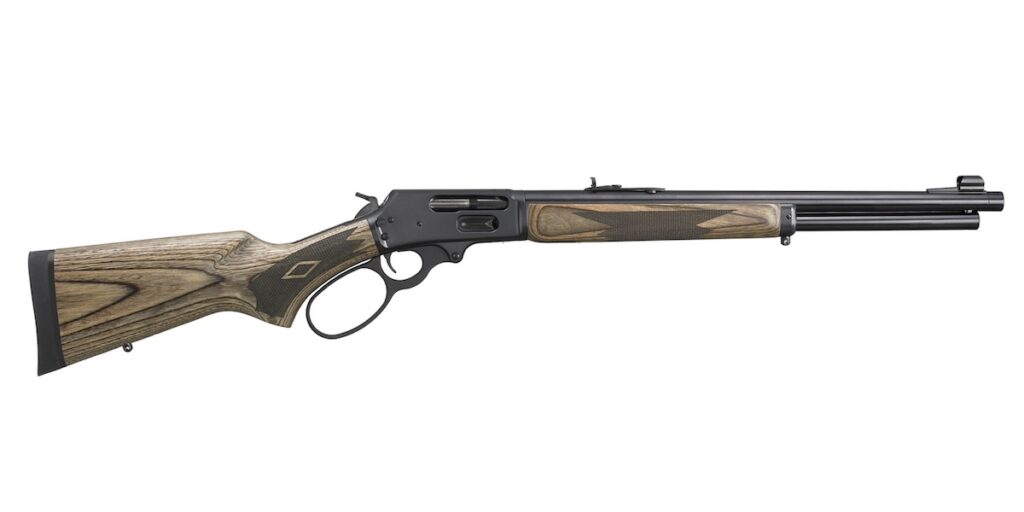
In particular, the Marlin Model 1895G Guide Gun (pictured above) is one of the most iconic .45-70 rifles in current production and is a favorite among hunting guides in places like Alaska who need a fast pointing and hard hitting rifle in case they must deal with an angry grizzly or brown bear at close range.
Those aren’t the only 45-70 rifles available, or indeed, the only models Marlin has ever made in that chambering. Indeed, I personally own a limited edition Model 1895 with a 24″ barrel, so there are several other versions of that rifle floating around out there.
In addition to the Marlin lever action, the various Henry .45-70 rifles are also very nice and are continually growing in popularity. Winchester also continues to manufacture the legendary 1886 in .45-70.
Additionally, though it’s no longer in current production, the Ruger No. 1 single shot rifle was manufactured in .45-70 for a time and those rifles can be found occasionally on the secondary market. Finally, a number of Siamese Mauser bolt action rifles were converted to .45-70 over the years, so they’re an option as well for someone who wants a bolt action .45-70.
30-30 vs 45-70: Which Is Right For You?
Do you primarily hunt medium sized game like whitetail deer, feral hogs, or black bear at ranges within 200 yards? Both are extremely effective deer hunting cartridges and will absolutely get the job done on medium sized game if you do your part. Since they’re both common in fast handling and easy to carry lever-action rifles, both cartridges are well suited for situations where you’ll be hunting in thick brush or in the tight confines of a deer stand.
The .30-30 in particular is a great deer hunting cartridge and remains one of the most popular North American hunting cartridges. Don’t let anybody try to tell you that the .45-70 is overkill on deer. There’s not a darn thing wrong with using the .45-70 on deer (I certainly have), but it’s really more gun than you need for that sort of work though. It’s admittedly a little rougher on both the shoulder and wallet than the 30-30 though.
Are you looking for the cartridge better suited for long range hunting for game like mule deer or pronghorn in open country where you might need to take a shot at several hundred yards? While both have a much longer effective range than cartridges like the .45 Colt and .44 Magnum when fired from a carbine, neither the .30-30 nor the .45-70 is a good choice for hunting situations where you might need to take a shot at ranges over 200 yards.
Of the two, the .30-30 Winchester does have a flatter trajectory and a little bit longer effective range, especially when using modern ammunition like Hornady’s LEVERevolution line. You might be able to make a shot on a deer out to around 300 yards or so under ideal conditions with the 30-30, but I think that’s pushing it if we’re being honest. Something like the 7mm Rem Mag, the .30-06, or even the 6.5 Creedmoor is a much better choice for that sort of hunting at longer ranges.
That said, I personally made one of my longest shots on a game animal using a 45-70. I won’t bore you with the details here, but I successfully connected on a red hartebeest in Namibia 365 yards away with a Marlin 1895 using iron sights many years ago.
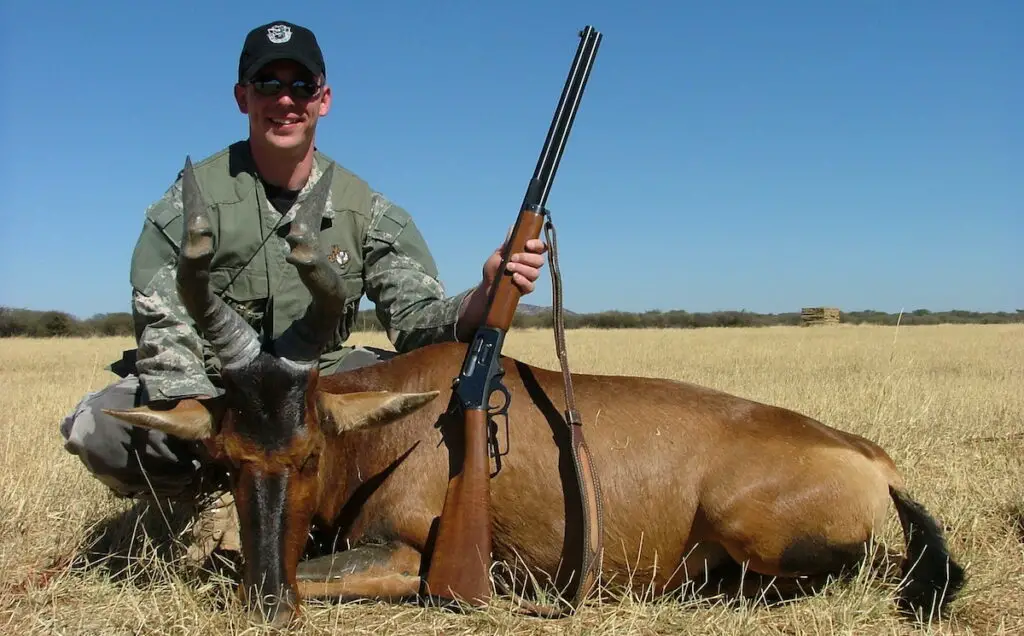
I would NOT recommend attempting a shot like that yourself, but that’s a good example of that the cartridge can certainly get the job done at a longer range than you might think.
Do you want a hunting cartridge that’s well suited for use on bigger game like bison, moose, or elk hunting? The .30-30 will certainly get the job done on those bigger creatures with good shot placement and when using high quality ammunition.
For instance, the woman in the video below used a .30-30 Winchester (in what looks like a Savage Model 170 pump action rifle) to take a moose with a couple shots at close range. If you watch carefully, you can see steam coming from the entrance and exit wounds of that moose right before it falls over.
That said, I personally think the .45-70 Govt is the better choice for these type of hunts because it just hits so much harder and uses significantly larger diameter and heavier bullets.
Regardless of which cartridge you choose, realize that your effective range is fairly limited with these cartridges, especially on really large game. They’re both certainly capable of cleanly and ethically taking bigger game, but you should only take shots within 150 yards or so (100 yards is even better).
That’s exactly what Steve Behnke (aka Mr. Big Kid) did when his shot the bison pictured below in 2022 on a hunt in Colorado with his tricked out Model 1895 in 45-70.
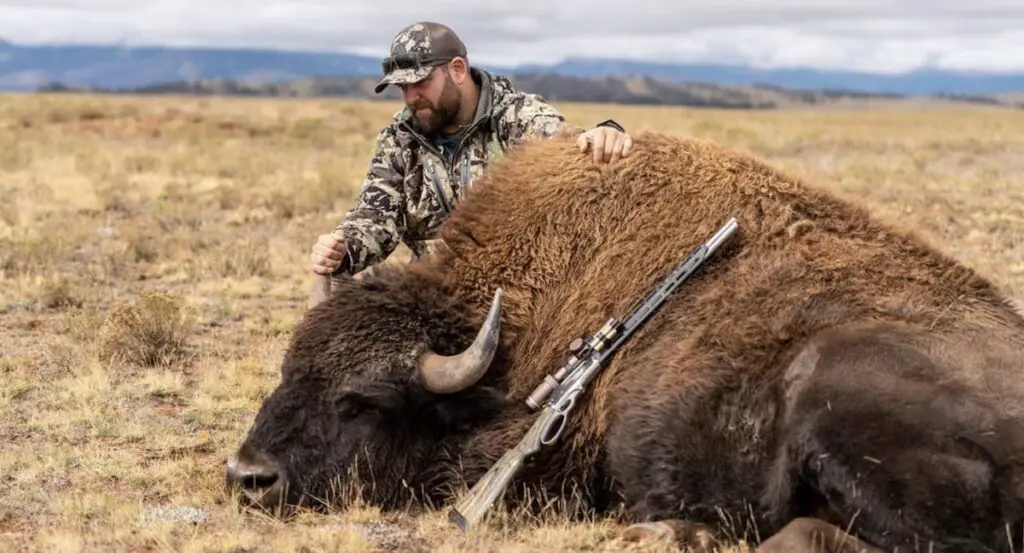
Are you specifically hunting brown or grizzly bear? What if you hunt in Canada or Alaska and need a heavy hitting cartridge just in case you find yourself on the wrong end of a grizzly/brown bear attack? Once again, the .45-70 Government is the best choice here hands down and is one of the best bear defense cartridges available. After all, there’s a reason why the Marlin Guide Gun is so popular among hunters and outfitters in Alaska. It’s a great gun with lots of stopping power and there are few other rifles I’d rather have in my hands if I had to deal with a charging brown bear!
Do you need a cartridge ideally suited for hunting thick-skinned dangerous game like cape buffalo or water buffalo? I strongly recommend against using both cartridges for hunting thick-skinned dangerous game. Not everybody agrees with me on this and there are a few hunters who have successfully taken cape buffalo with the .45-70. While I think the .45-70 Govt is great cartridge, there are good reasons NOT to hunt cape buffalo with it and I’ve written a comprehensive article explaining why I think hunting cape buffalo with the 45-70 is a bad idea.
Are you sensitive to recoil and in need of a lower recoiling cartridge? The .30-30 Winchester is easily the best choice here and that cartridge has a reputation for manageable recoil, even in lightweight and easy to carry rifles. That said, even the .30-30 Winchester might still be too much for extremely recoil sensitive shooters to handle.
The .30-30 Winchester and .45-70 Government are both excellent rifle cartridges. While there is quite a bit of overlap in their capabilities, realize that they’re best suited for different hunting conditions: the .30-30 for use on deer sized game and the .45-70 for bigger and/or dangerous game where you need lots of power in a fast pointing rifle. All things considered, the difference between them (30-30 vs 45-70) is fairly big in some areas (like with recoil and effectiveness on bigger game).
So, carefully analyze your potential needs before making a decision. If you really need the advantages the .45-70 Government offers, then by all means purchase one. However, the .30-30 Winchester will work really well for most hunters, especially if they mainly hunt game like deer and feral hogs. In the end, a lot of this decision comes down to personal preference. So, choose the one that you feel most comfortable with and it will probably serve you well afield. Good luck!
NEXT: 308 vs 30-06 SPRINGFIELD vs 300 WIN MAG: WHICH SHOULD YOU HUNT WITH?
Enjoy this article comparing the .30-30 Winchester and .45-70 Government cartridges? Please share it with your friends on Facebook and Twitter.
The Lyman 50th Edition (p234-236 and p358-360) and Hornady 10th Edition (p444-447 and p754-761) reloading manuals were used as references for the history of the cartridges. I obtained the data used to compare the trajectory of the cartridges from Hornady (here and here), Buffalo Bore (here and here), and Remington (here and here). Data used to calculate recoil was obtained from the Hornady reloading manual. Case capacities were obtained from Kwk (here). Maximum pressure obtained from SAAMI (p29 & 34). I used ShootersCalculator.com to compare trajectory and recoil for the cartridges.
Make sure you subscribe to The Big Game Hunting Podcast and follow The Big Game Hunting Blog on Facebook, Instagram, Twitter, and YouTube.
John McAdams is a proficient blogger, experienced shooter, and long time hunter who has pursued big game in 8 different countries on 3 separate continents. John graduated from the United States Military Academy at West Point and is a veteran of combat tours with the US Army in Iraq & Afghanistan. In addition to founding and writing for The Big Game Hunting Blog, John has written for outdoor publications like Bear Hunting Magazine, The Texas State Rifle Association newsletter, Texas Wildlife Magazine, & Wide Open Spaces. Learn more about John here, read some of John’s most popular articles, and be sure to subscribe to his show: the Big Game Hunting Podcast.

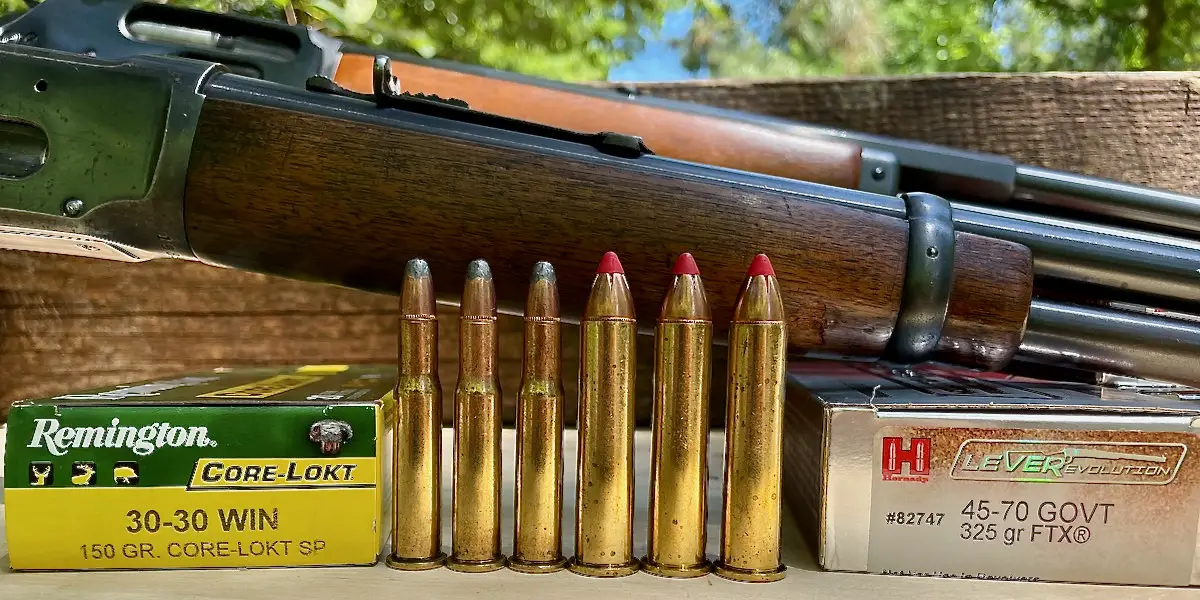

Excellent article. Thanks!